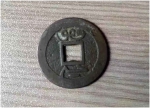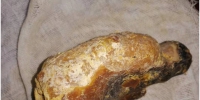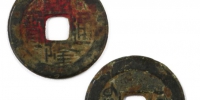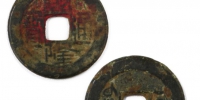古玩行2019精品推荐第11期:乾隆通宝
乾隆通宝是乾隆时期的流通货币, 乾隆皇帝在位的60年里施展其“文治武功”的治国策略,创造了封建社会里最后一个辉煌盛世,之后民间便盛传佩带“乾隆通宝”铜钱可驱灾辟邪,又因乾隆二字谐音“钱隆”而备受后世藏家所喜爱的钱币。
Qianlong Tongbao was the currency of Qianlong period. During the 60 years of Emperor Qianlong's reign, he used his strategy of "governing the country with culture and martial arts" to create the last glorious era in the feudal society. After that, it was widely spread among the people that wearing "Qianlong Tongbao" copper coins could drive away disasters and evil spirits. Because of the homonym "Qianlong", the coins were loved by later collectors.
【藏品名称】:乾隆通宝
[collection name]: Qianlong Tongbao
【类别】:钱币
Class: Coins
清代各年号均铸有钱币,钱文一般以满文和汉文两种文字。铸有顺治通宝,康熙通宝,雍正通宝,乾隆通宝,嘉庆通宝,道光通宝...鉴定主要从三个方面来把握。一是断定古钱币的时代,二是确定古钱币的真伪,三是认定古钱币的珍贵程度。古钱币的断代,在有年号的钱币中断定一般不成问题。由于钱币在历代就具有很高的收藏价值,故在各个历史时期均有仿冒钱币出现,如何鉴定其真伪难度较大。鉴定真伪一定要从钱币的形状、质地、包浆、文字和制作工艺等诸多方面来识别。每一时期的钱币,形状、质地和文字都有其独特的风格和特征。各个历史时期的铸造工艺不尽相同,仿冒者不可能完全把握。钱币的价值如何,要看钱币的年代和存世的数量多寡来确定。钱币不仅有经济价值,更有历史价值和艺术价值,而历史价值和艺术价值又直接影响着经济价值。
In the Qing Dynasty, coins were cast in every year, and the characters of money were generally Manchu and Chinese. There are three ways to identify Tongbao: Shunzhi Tongbao, Kangxi Tongbao, Yongzheng Tongbao, Qianlong Tongbao, Jiaqing Tongbao, Daoguang Tongbao. The first is to determine the age of the ancient coins, the second is to determine the authenticity of the ancient coins, and the third is to determine the value of the ancient coins. The dating of ancient coins is generally not a problem when the coins with year numbers are interrupted. Since coins have a high collection value in the past dynasties, there are counterfeit coins in various historical periods, so it is difficult to identify their authenticity. To identify the authenticity of coins, we must recognize them from the shape, texture, size, character and making process. Each period's coins, shape, texture and characters have its own unique style and characteristics. The casting process in different historical periods is not the same, so the counterfeiters can not fully grasp it. The value of money depends on the age and the number of coins. Money has not only economic value, but also historical value and artistic value, which have a direct impact on economic value.
该钱币铸于清高宗乾隆年间(1736-1795年),背面的满文比较复杂。钱面文字"乾隆通宝"以楷书书写,其字从上而下而右而左直读。钱背文字沿雍正满文钱式穿孔左边有"宝"字,穿孔右边铸有各局名。币种与不同时期形状与大小也有不同。古代钱币传世量到现在有很多古币都没有得到一个比较好的保存。真正在现代人的手上作为收藏品的也只是以前也就是当代流通钱币的冰山一角都不值一谈。古钱币的收藏价值也因此而变得高贵,存在历史收藏重大意义。特别是一些比较珍稀品种。如乾隆通宝其实只是一个大归类。
This coin was cast in the reign of Emperor Qianlong of Gaozong of Qing Dynasty (1736-1795). The Manchu characters on the back of the coin are complex. Qian Mian character "Qianlong Tongbao" is written in regular script, and its characters are read directly from top to bottom, right and left. The characters on the back of money have the word "Bao" on the left side and the names of bureaus on the right side. The shape and size of currency and different periods are also different. Many ancient coins have not been well preserved until now. What is really in the hands of modern people as a collection is only that the iceberg of the former and the current currency is not worth talking about. As a result, the collection value of ancient coins becomes noble, which is of great significance in historical collection. Especially some rare varieties. For example, Qianlong Tongbao is only a big category.
铸行“乾隆通宝”要求仍重一钱二分,该钱书法铸工都比雍正时更为精美。最初清政府仍继续执行通货紧缩的政策。钱局较雍正时有所增减,首先在乾隆四年,停了宝河、宝巩、宝济三局,于乾隆五年时开宝福局,七年开宝桂局,十年开宝直局。乾隆朝以前的制钱不加锡,以铜、铅、锌配制,称之为“黄钱”,在乾隆五年规定在铸钱铜料之中加百分之二的锡,称为“青钱”。官方说是为杜绝私钱,实则无异于减重。“乾隆通宝”版式很多,钱文方面京局的多用宋体宝浙局多用楷书,宝陕、宝顺两局用隶书,但大多数地方钱局用宋体。乾隆四十年时,私铸情况日盛,各省官员出现盗铸,政府对此无计可施,加上云南铜产量逐年递减,导致铜价飞涨,铸钱成本也随之水涨船高。我国古代钱币前史悠长,源源不绝,种类纷乱,多姿多彩,是中华民族传统文明中的瑰宝。
The "Qianlong Tongbao" still requires one yuan and two cents, which is more exquisite than the Yongzheng period. At first, the Qing government continued to implement the policy of deflation. First of all, in Qianlong's fourth year, Baohe, Baogong and Baoji Bureau were stopped. In Qianlong's fifth year, Baofu Bureau was opened, Baogui Bureau was opened in seven years and Baozhi Bureau was opened in ten years. Before the Qianlong Dynasty, no tin was added to the money, which was made up of copper, lead and zinc. It was called "yellow money". In the five years of Qianlong, it was stipulated that two percent of tin should be added to the copper material for making money, which was called "green money". Officials say it's to eliminate private money, but in fact, it's just to lose weight. There are many formats of "Qianlong Tongbao". In terms of money and culture, Beijing Bureau mostly uses regular script in song style, while Baoshan Bureau and Baoshun Bureau use official script, but most local money bureaus use song style. In Qianlong's forty years, the situation of private casting became more and more prosperous, and the officials of various provinces began to steal casting. The government had nothing to do about it. In addition, the copper production in Yunnan decreased year by year, which led to the soaring price of copper and the cost of casting money. Chinese ancient coins have a long history, endless sources, various kinds, and are treasures of Chinese traditional civilization.
随着钱币收藏行情的不断升温,古钱币逐渐进入藏家的眼球,各地钱币交易会上,古钱币专场也多次交易出好价。古钱币具有较大收藏投资空间,升值最快的当数其中的珍品类古钱币,在市场上十分受追捧,涨幅很大。清代乾隆时期,作为中国古代最后一个盛世,其发行的流通货币乾隆通宝,在收藏市场一直有着很高的收藏价值。
With the continuous warming of the money collection market, ancient coins gradually enter the eye of collectors. At various currency fairs, ancient coins are also traded at good prices for many times. Ancient coins have a large collection investment space, and the most rapid appreciation is the precious ancient coins, which are very popular in the market, with a large increase. In the Qianlong period of the Qing Dynasty, as the last prosperous period in ancient China, the currency issued by Qianlong Tongbao had a high collection value in the collection market.
企业联系电话:400 686 3616








